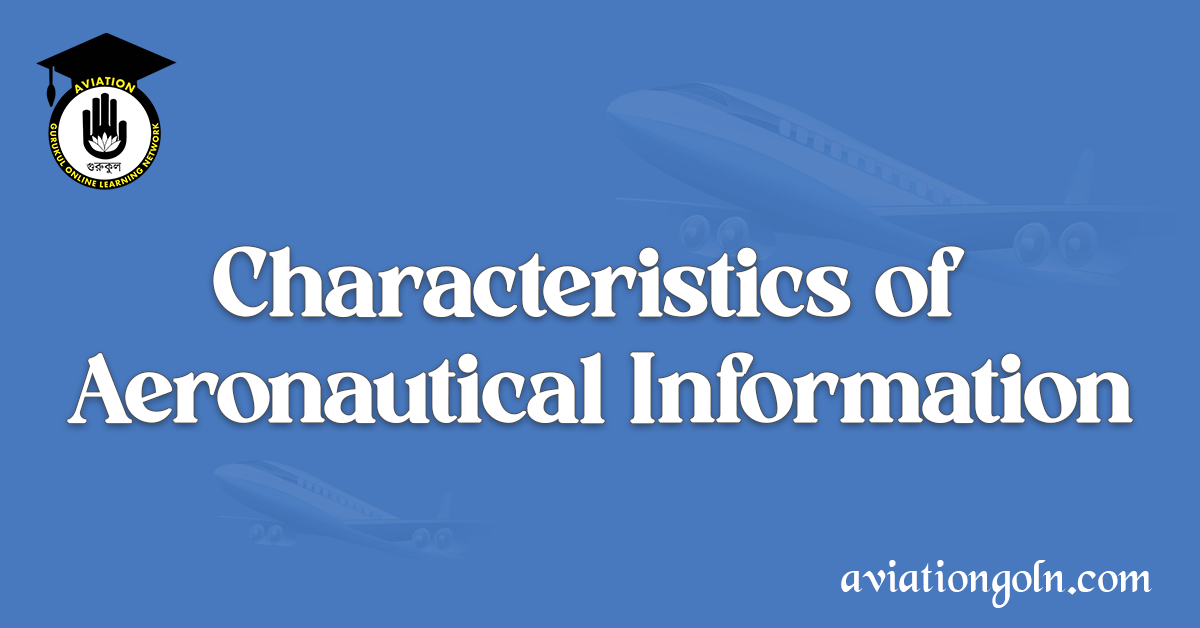Characteristics of Aeronautical Information: The aviation industry relies heavily on precise and timely information for safe and efficient aircraft operations. This information, known as aeronautical information, encompasses a vast range of data, from the specifications of an aircraft to weather forecasts and airport details. This article delves deep into the core characteristics of aeronautical information, aiming to provide a comprehensive understanding of its significance and scope.
Characteristics of Aeronautical Information

1. Introduction
Aeronautical information plays a pivotal role in the intricate machinery of global aviation. Every phase of a flight, from its planning to its execution and eventual completion, requires the utilization of accurate and up-to-date aeronautical data. This data aids pilots, air traffic controllers, airline operators, and other stakeholders in making informed decisions that ensure safety and efficiency.

2. Accuracy
- Precision: A defining trait of aeronautical information is its high level of precision. Whether it’s the coordinates for navigation waypoints, the length and width of runways, or the specifications of airspace restrictions, the margin for error is extremely slim. Incorrect data can lead to operational inefficiencies or, more critically, pose severe safety risks.
- Consistency: The information must be consistent across various platforms and tools. For instance, the data available on a pilot’s electronic flight bag should match that available to the air traffic controller.

3. Timeliness
Aeronautical information is often time-sensitive, especially when it comes to meteorological data or Notices to Airmen (NOTAMs).
- Real-time Updates: Certain sectors of aviation, such as air traffic control, require real-time or near-real-time data. Any delay can result in inefficiencies and, in some cases, can pose significant safety concerns.
- Scheduled Updates: Some aeronautical data is updated at scheduled intervals. For instance, charts and maps used by pilots are updated periodically to reflect new infrastructure, modified airspace, or other changes.

4. Relevance
The vast scope of aeronautical information means that not all data is relevant to every aviation stakeholder. For instance:
- Pilots require detailed information about their route, possible diversions, weather conditions, and other flight-specific details.
- Air traffic controllers need data on all flights operating within their jurisdiction, airspace configurations, weather updates, and more.
- Maintenance crews may focus on specific aircraft technical data and relevant regulations.

5. Accessibility
In the digital age, aeronautical information should be readily accessible:

- Digital Platforms: Tools like Electronic Flight Bags (EFBs) and computer-based air traffic control systems provide instant access to vast amounts of data.
- Interoperability: Given the global nature of aviation, it’s crucial for different systems and platforms across countries and organizations to communicate seamlessly. The information should be in standardized formats, ensuring that data retrieved from one system can be used and understood by another.

6. Clarity
Ambiguity can be a serious hindrance in aviation operations:
- Unambiguous Language: The aviation industry relies heavily on clear, standardized language. For instance, English is the international language for aviation operations.
- Standardized Symbols and Notations: Charts and maps use standardized symbols, ensuring pilots from any country can understand them.

7. Authenticity and Reliability
Considering the potential consequences of inaccurate data, the sources of aeronautical information must be trustworthy:
- Verification and Validation: Information, especially that which impacts flight safety, undergoes rigorous checks before dissemination.
- Redundancy: Critical systems usually have backup data sources to ensure continuous availability of information.

8. Completeness
Partial information can sometimes be as harmful as inaccurate information:
- Holistic Data Capture: For example, while detailing a new airport’s information, everything from its location, runways, taxiways, communication frequencies, nearby obstacles, services available, and more needs to be documented.

9. Confidentiality
Certain aeronautical information may be sensitive:
- Security Protocols: Ensure that only authorized personnel can access specific categories of data.
- Data Encryption: Digital platforms should have robust encryption to prevent unauthorized data interception and tampering.

10. Retrievability
The vast amount of aeronautical data necessitates effective storage and retrieval systems:
- Search Features: Advanced search algorithms allow users to quickly retrieve specific pieces of information from vast databases.
- Archival: Older data, while not immediately relevant, might be needed for analysis, research, or investigation.

Aeronautical information is the backbone of aviation operations worldwide. Its core characteristics of accuracy, timeliness, relevance, and clarity, among others, underscore its importance in maintaining the safety and efficiency of flights. As aviation continues to evolve, the systems and protocols surrounding aeronautical information will inevitably become even more sophisticated, ensuring that this critical data remains a reliable foundation for the industry.
